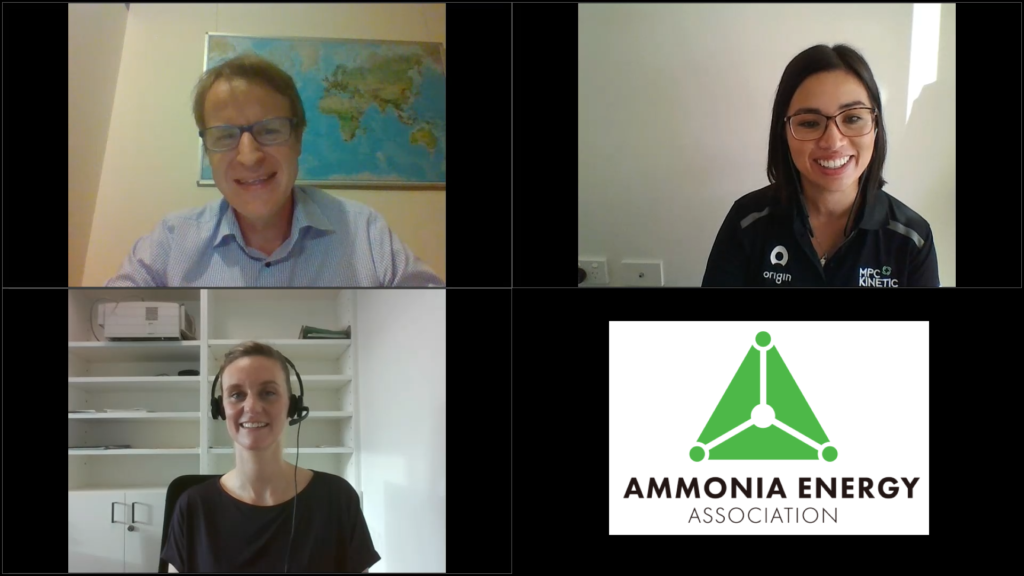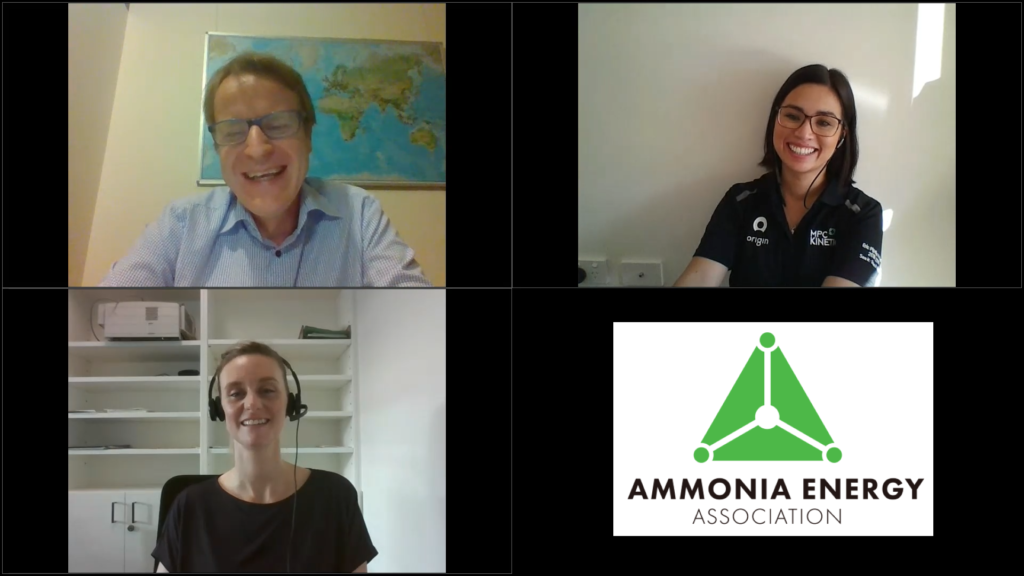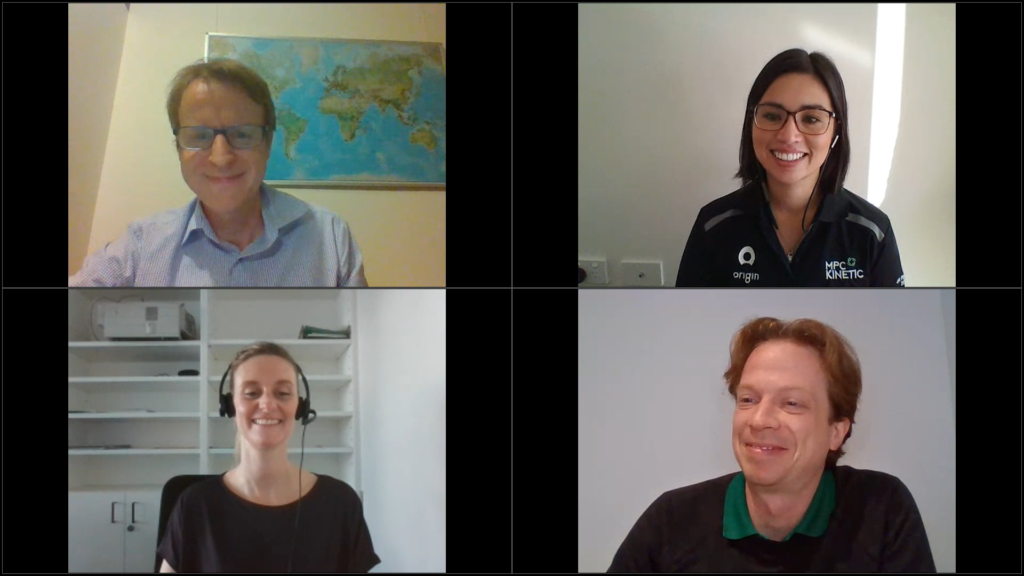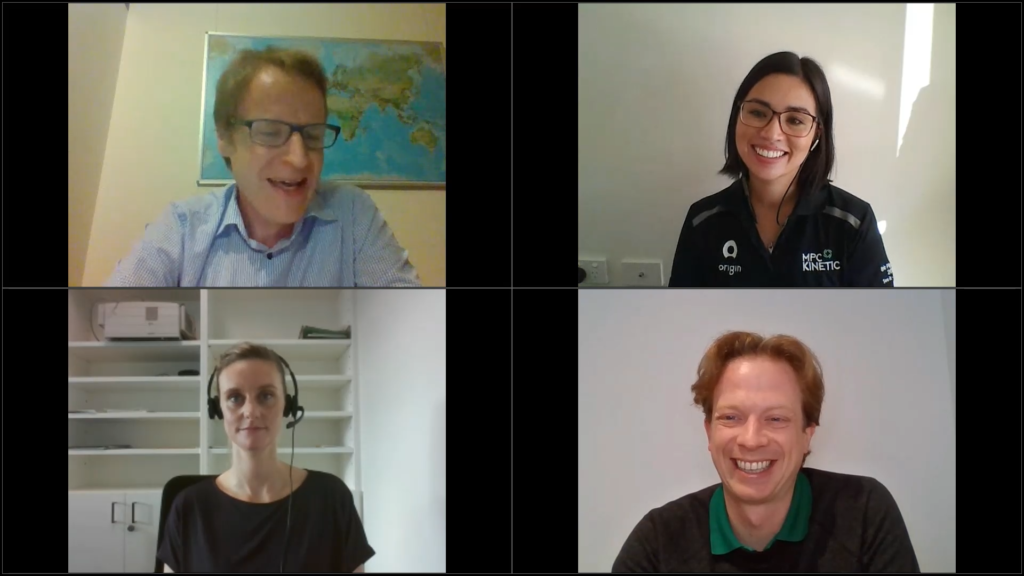Ammonia Energy Live March 2021: event wrap
By Julian Atchison on April 07, 2021
Last fortnight we presented the second episode in our new webinar series: Ammonia Energy Live. Every month we’ll explore the wonderful world of ammonia energy and the role it will play in global decarbonisation – with an Australian twist.
This episode we welcomed Sammy Van Den Broeck, VP Project & Portfolio at Yara Clean Ammonia. Sammy was invited to give his thoughts on the key challenges and opportunities in the global ammonia transition, and explain to us why Australia is so important to Yara’s future clean ammonia plans. Interviewing Sammy were Jacinta Bakker (Research Fellow in the MacFarlane Laboratory at Monash University) and Allison Gwilt (Senior Project Engineer, Future Fuels at Origin Energy).
AG: Firstly Sam, some people out there may not know you or your company Yara, so can you please tell us a little about yourself and how you came to be associated with ammonia and with the AEA?
SvdB: By education I’m a bio-engineer. But, I didn’t study it just to keep our air and waterways clean – I was always interested in GHG emissions and abatements. I’ve also got four kids, and I want to give them a socially responsible answer to climate change.
For the last two years I’ve headed up the Climate Neutral Solutions team at Yara. We’ve been looking at all the possible decarbonisation solutions within reach, and chief among them has been clean ammonia. In just the last month we’ve formed a new business unit focused solely on clean ammonia (and reporting directly to Yara’s CEO) – lots of progress!
In terms of the AEA, Yara has been a pioneer as one of its first board members and charter sponsors. It’s a long-standing relationship we’re proud to have.
JB: In your press releases, you explain clean ammonia is not only essential for decarbonising the food industry, but can be a gateway to the hydrogen economy, can you explain that a bit further?
SvdB: Sure can. I think we can call ammonia the hidden jewel of the hydrogen economy. Today I heard someone say it will be the workhorse of the hydrogen economy – they’re both great descriptors.
Ammonia’s advantages over hydrogen are well-documented:
- It has a higher volumetric energy density than hydrogen.
- It transports at minus 33 Celsius. Much more efficient than the minus 253 required for hydrogen transport.
- No carbon in the molecule.
- And, it can be produced easily at scale using renewable energy – something that can’t be said of other e-fuels.
AG: You explained why clean ammonia is arguably the best zero carbon shipping fuel, can you also mention some potential drawbacks?
SvdB: Despite its advantages over hydrogen, it’s still a toxic compound – it needs to be handled with care and all necessary precaution. But, the ammonia industry has been around for more than a hundred years, so there’s lots of expertise there to draw from.
Marine engine development and fine-tuning is still in progress: we hope everything is on track for 2024 deployment. We also know that NOx emissions from marine engines can be dealt with using selective catalytic converters, which are widely available, proven technologies.
To mitigate all this Yara is extremely active in getting pilots on the water ASAP. Two projects, one in partnership with Wartsila in Norway and the other with the Port of Singapore Authority (as well as Samsung Heavy Engineering & Lloyd’s Register) spring to mind. We really want to work on these challenges and help bring ammonia-propelled vessels into commercial reality.
JB: Understood. Do you think Yara is well placed to expand its horizon from fertilizers into ammonia energy and shipping fuel space?
SvdB: We certainly think so, and we’re ready! Not only are we one of the leading producers of ammonia globally, but 25% of the world’s traded ammonia passes through Yara’s hands every year. That brings a vast amount of knowledge, experience and infrastructure. Unlike hydrogen – where we’ll have to wait for infrastructure to be built – we’ve got existing ammonia ports and terminals all over the world. Where marine fuel is concerned we’ve got ammonia infrastructure ideally located for the world’s biggest bunkering ports: Singapore, Rotterdam and Houston.
AG: Sam, you talked about clean ammonia projects, can you tell us a bit more around that?
SvdB: We’ve built up a portfolio of three projects that deliberately have different characteristics: one in Australia (solar), one in Norway (hydro) and one in the Netherlands (offshore wind). These three are all slated to come online between 2023 and 2025, including our first “world-scale” project in Norway. So not only are we focused on getting 100MW electrolyser pilots up and running, but also adapting our primary Norwegian ammonia plant to run on half a GW of hydro power!
JB: Speaking a bit more locally, Yara, together with ENGIE, is developing a project at its ammonia facility in the Pilbara, Western Australia, what is so unique about this project?
SvdB: So many things!
- Location – wonderful solar resources and perfectly positioned to access the Asian market.
- Built on Indigenous country, and we have a very good relationship with the traditional owners, represented by the Murujuga Aboriginal Corporation.
- Located next to an existing ammonia plant and its key utilities. For example, water will be provided by a desalination unit at the existing Pilbara plant. There’s also existing export facilities to tap into.
But most of all in an Australian (and perhaps global) context is the project’s overwhelmingly successful development phase. We’ve worked closely with ENGIE for over two years now, and, subject to a grant decision from the Australian Renewable Energy Agency in about a month’s time, the project should soon reach financial close. There’s a lot of talk and a lot of conferences on green hydrogen and ammonia, but we’re almost ready to put steel in the ground, which is still a rarity. We hope we can get it all moving very, very soon.
AG: That’s very exciting news on the progress of the pilot. Do you have a vision to build a mega project like the Asian Renewable Energy Hub or any greenfield (ie. new) facilities, not just developing an existing facility?
SvdB: Yes, but we’re still deciding on timing.
We feel the prime spots to start are the existing or brownfield facilities. This lets you avoid large capital costs on new ammonia synthesis (Haber Bosch) loops. The time will come in Australia and we want to be part of it, either as a partner or an off-taker.
JB: So all this progress aside, what are the major hurdles towards bigger project development?
SvdB: A lot of the hurdles for clean ammonia projects reside directly around cost, not only the CapEx of producing electrolytic hydrogen but also the OpEx cost of purchasing renewable power.
We need policy frameworks and regulatory certainty around the market, especially to support first movers. The CapEx support program ARENA is administering (and which will hopefully assist the Pilbara project to financial close) is a great first step, but more is needed. Reverse auction tenders have been enormously successful in the renewable energy world, so why not use them to give first movers on green hydrogen and green ammonia investment certainty?
Carbon prices are important, but in a global, holistic sense. Calculating the carbon intensity for a product up to and including its consumption gives incentive for the whole supply chain to decarbonise.
AG: Interesting. Can you elaborate more and what Yara believes to be in place to fast-track the market? What policies are necessary for early demand growth?
SvdB: You bring up the really important point of policy. I really feel we need to take a global, harmonised view on this. Certification – which includes carbon foot printing and point of origin guarantees – currently has no agreed on global rules, and is very much still a supplier-customer discussion (when it happens at all).
Basically, we really want to know when we can call our Pilbara ammonia green and how our decisions on plant design will impact certification. If we have a hybrid setup with one part green, do we need to distribute carbon intensity across the full volume of our product to achieve a certain level of certification? Or can we designate intensity across our operations and final product? These are big questions. We know the Ammonia Energy Association is very active regionally and globally on this matter, and we look forward to more developments.
JB: Makes a lot of sense Sam. And the million dollar question: do you have a line-up of customers willing to pay?
SvdB: That is indeed the million – or the billion – dollar question for large projects!
From a final consumer standpoint this is all very achievable. Green fertiliser will cost 2-4x more than traditional fertiliser, and if you translate that into a loaf of bread it would be a few dollars more expensive. If you use ammonia as zero-carbon shipping fuel to transport Nike shoes or Levi jeans across the world, the costs of these products would only rise six or seven dollars. For end consumers this is not unreasonable at all.
But of course it’s not that simple: farmers, ship owners and manufacturers have to pay that bill first, and they won’t feel confident paying unless they have full visibility of the whole supply chain, and that final consumer demand will be guaranteed for a premium product.
But there are good early signs. The big players and key consumers are all positioning themselves to pay, and we’re starting to get to the point of finalising term sheets etc. with major clients. It’s not a massification market yet, but it’s promising.
AG: Final question, and thanks for letting Jacinta and I interrogate you today! How can the AEA contribute to the development of the ammonia energy industry, particularly here in Australia?
SvdB: Definitely continue what they’re already good at doing! Getting different actors in the value chains together, setting up constructive dialogues with policy makers and educating people on how we can accelerate this super-exciting opportunity for green ammonia. I know the AEA have core working groups on Certification as well. If the AEA is working on developing these support mechanisms I talked about they can help make sure they’re done correctly. Bringing society and industry together to move forward has great merit, and that’s why we like being part of AEA.
Audience Q&A
How does Yara define “clean ammonia”? And, in a related, pre-submitted question, what is Yara’s view on blue ammonia and blue hydrogen?
SvdB: Good question. It’s not a coincidence that we’ve called it “Yara Clean Ammonia” and not “Yara Green Ammonia”. We’re convinced green will be the long-term winner, as the costs of electrolyser technology and renewable power come down. But, in the transition, we see a space for blue ammonia. This is because of customer demand: yes, many are focused intently on green (for very good reason), but there are also many customers who are after blue product.
Blue ammonia will be most useful connected to existing plants, especially those close to potential carbon storage sites. We are more doubtful on greenfield/new-build blue ammonia that uses CCS. We see a space for blue and green in Australia, even though our Pilbara project is focused exclusively on green production.
What about clean supply chains, clean equipment, clean plant infrastructure for Yara facilities? If the aim is to reduce GHG, there must be a focus on these too?
SvdB: Another very sharp question. Of course we’re most focused on changing operational energy use to reduce GHG emissions, but a future focus on the supply chain is key. This is already happening: you see many electrolyser manufacturing facilities in Europe now running on solar and other renewable power sources. We haven’t fully quantified the carbon footprint of our infrastructure, but we’ll definitely have to in the future.
Ammonia via electrolysis: scale or distribution?
SvdB: All elements are important, but scale moreso. Doesn’t matter whether you’re talking about ammonia, methanol or any other manufactured chemical product – scale matters to get the costs down. When we add in the future demands for marine fuel, again, scale is key. Ammonia infrastructure is already “known”, and the build-out of what’s currently in the pipeline will get us through the first couple of million tonnes of clean ammonia demand. But after that much more is needed!
Countries leading support for clean & green hydrogen, and what more can governments do?
SvdB: The EU is very proactive, with 6GW of hydrogen ambition by 2024. Australia, the US and India all show encouraging signs (there’s a lot of noise coming out of India).
In terms of what governments can do, we’ve already covered some of the mechanisms and I will emphasize that there’s not one simple recipe. We need support for first movers, but also increased visibility on the market, regulations and demand-side measures (for example, quotas for fuel blending in shipping) to create a clearer business case. With a better business case things will be financed more easily and more cheaply.
Register for April episode & our new YouTube channel
Register here to view a recording of this event, or head over to AEA Australia’s new YouTube channel to watch this event and other great content.
Coming up in April is Hazer Group, a relatively new player on the Australian scene who use methane pyrolysis to produce low-carbon hydrogen. Hazer’s CEO Geoff Ward will give us insights into recent announcements from the group, their future plans and just how ammonia fits into an emerging hydrogen economy in Western Australia. Thursday 29 April, 2PM AEST. Register here and join us then. Even if you can’t make the event live, register and we’ll send you a link to watch the recording shortly after the event finishes.





